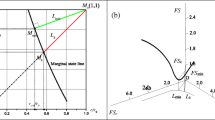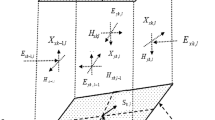Abstract
The analysis of slope stability problems may often require considerable attention for 3D effects, such as the curvature of the slope, the contribution of the piles and the local loading of the slope by the structures. In this paper, the effect of each contributing factor on the global stability of a 3D slope was carefully and comprehensively investigated by making use of a field case. However, the conclusions drawn from these analyses are not specific to a single case study. Using a couple of hundred analyses that were run within the context of this paper, some guidelines were provided and the influence of each factor on the factor of safety was clearly stated. The results indicated that, the influence of plan curvature can be defined with a unique relationship based on the factor of safety of the slope which is itself directly proportional to the radius of curvature of the slope. Considering the case of local loading on top of the slope, the loading distance and the size of the numerical domain on the shape of the failure mechanism were investigated in this paper and these effects could be demonstrated in the light of the results. Moreover, the influence of piles on slope stability was studied not only for the common “no surcharge case”, but also for different loading conditions in order to optimize the effective pile location. The effect of the pile cross-sectional shape was also discussed in order to optimize the CPU time. Thus, the results of this study are intended to reveal some key issues and bring insight into the design processes.
Similar content being viewed by others
References
Cai, F. and Ugai K. (2000). “Numerical analysis of the stability of a slope reinforced with piles.” Soils Found, Vol. 40, No. 1, pp. 73–84, DOI: 10.3208/sandf.40.73.
Cheng, Y. M., Lansivaara, T., and Wei, W. B. (2007). “Two-dimensional slope stability analysis by limit equilibrium and strength reduction methods.” Comput Geotech, Vol. 34, No. 3, pp. 137–150, DOI: 10.1016/j.compgeo.2006.10.011.
Cheng, Y. M. and Lau, C. K. (2008). Slope stability analysis and stabilization: New methods and insight, Taylor and Francis. London.
Donald, I. B. and Giam, S. K. (1988). “Application of the nodal displacement method to slope stability analysis.” Proceedings of the 5th Australia-New Zealand Conference on Geomechanics, Sydney, Australia, pp. 456–460.
Griffiths, D. V. and Lane, P. A. (1999). “Slope stability analysis by finite elements.” Geotechnique, Vol. 49, No. 3, pp. 387–403, DOI: 10.1680/geot.1999.49.3.387.
Hassiotis, S., Chameau, J. L., and Gunaratne, M. (1997). “Design method for stabilization of slopes with piles.” ASCE J Geotech Geoenvr Engrg, Vol. 123, No. 4, pp. 314–323, DOI: 10.1061/(ASCE)1090-0241(1997)123:4(314).
Hoek, E. and Bray, J. W. (1981). Rock slope engineering, 3rd Edition, The Institute of Mining and Metallurgy, London.
Itasca (2009). Fast lagrangian analysis of continua in 3-dimension, FLAC 3D, Itasca Consulting Group, Minneapolis, USA.
Kelesoglu, M. K. and Cinicioglu, S. F. (2010). “Free-field measurements to disclose lateral reaction mechanism of piles subjected to soil movements.” J. Geotech. Eng. ASCE, Vol. 135, No. 2, pp. 331–343, DOI: 10.1061/ASCEGT.1943-5606.0000217.
Kelesoglu, M. K. and Springman, S. M. (2011). “Analytical and 3D numerical modelling of full-height bridge abutments constructed on pile foundations through soft soils.” Comput. Geotech., Vol. 38, No. 8, pp. 934–948, DOI: 10.1016/j.compgeo.2011.07.011.
Matsui, T. and San, K. C. (1992). “Finite element slope stability analysis by shear strength reduction technique.” Soils Found., Vol. 32, No.1, pp. 59–70, DOI: 10.3208/sandf1972.32.59.
Ng, C. W. W., Zhang, L. M., and Ho, K. K. S. (2001). “Influence of laterally loaded sleeved piles and pile groups on slope stability.” Can. Geotech. J., Vol. 38, No. 3, pp. 553–566, DOI: 10.1139/cgj-38-3-553.
Poulos, H. G. (1995). “Design of reinforcing piles to increase slope stability.” Can. Geotech J, Vol. 32, No.5, pp. 808–818, DOI: 10.1139/t95-078.
Wei, W. B. (2008). Three dimensional slope stability analysis and failure mechanism, PhD Thesis, The Hong Kong Polytechnic University.
Wei, W. B. and Cheng, Y. M. (2009). “Strength reduction analysis for slope reinforced with one row of piles.” Comput. Geotech., Vol. 36, pp. 1176–1185, DOI: 10.1016/j.compgeo.2009.05.004.
Wei, W. B., Cheng, Y. M., and Li, L. (2009). “Three-dimensional slope failure analysis by the strength reduction and limit equilibrium methods.” Comput. Geotech., Vol. 36, pp. 70–80, DOI: 10.1016/j.compgeo.2008.03.003.
Won, J., You, K., Jeong, S., and Kim, S. (2005). “Coupled effects in stability analysis of pile-slope systems.” Comput. Geotech., Vol. 32, pp. 304–315, DOI: 10.1016/j.compgeo.2005.02.006.
Wyllie, D. C. and Mah C. (2004). Rock slope engineering, 4th edition, CRC Press.
Xing, Z. (1988). “Three-dimensional stability analysis of concave slopes in plan view.” J. Geotech. Engrg., Vol. 114, No. 6, pp. 658–671, ISSN: 0733-9410/88/0006-0658.
Zhang, Y., Chen, G., Wang, B. and Li, L. (2013b). “An analytical method to evaluate the effect of a turning corner on 3D slope stability.” Comput. Geotech., Vol. 53, No. 9, pp. 40–45, DOI: 10.1016/j.compgeo.2013.05.002.
Zhang, Y., Chen, G., Zheng, L., Li, Y., Zhuang, X. (2013a). “Effects of geometries on three-dimensional slope stability.” Can. Geotech. J., Vol. 50, No. 3, pp. 233–249, DOI: 10.1139/cgj-2012-0279.
Zienkiewicz, O. C., Humpheson, C., and Lewis, R. W. (1975). “Associated and non-associated visco-plasticity and plasticity in soil mechanics.” Geotechnique, Vol. 25, No. 4, pp. 671–689, DOI: 10.1680/geot.1975.25.4.671.
Author information
Authors and Affiliations
Corresponding author
Rights and permissions
About this article
Cite this article
Kelesoglu, M.K. The evaluation of three-dimensional effects on slope stability by the strength reduction method. KSCE J Civ Eng 20, 229–242 (2016). https://doi.org/10.1007/s12205-015-0686-4
Received:
Revised:
Accepted:
Published:
Issue Date:
DOI: https://doi.org/10.1007/s12205-015-0686-4




